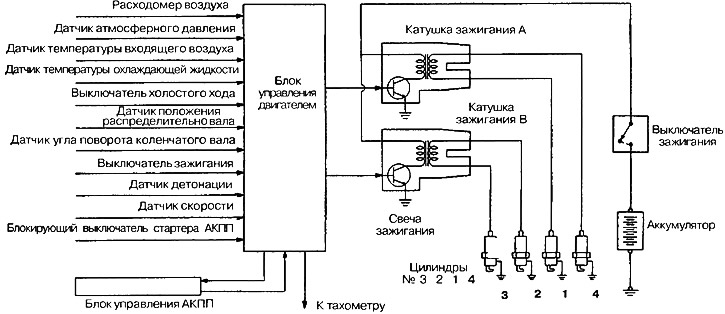Interruption of primary current from ignition coil A induces a high voltage in the secondary circuit of coil A. This high voltage is transmitted to the spark plugs of cylinders 1 and 4 to create an ignition spark. If by the time both spark plugs create a spark, one cylinder is on the compression stroke, the other cylinder is on the exhaust stroke, ignition of the compressed air-fuel mixture will occur only in the cylinder that is on the compression stroke.
In the same way, the process occurs in the ignition coil B. If the current of its primary circuit is interrupted, the high voltage created by this is applied to the spark plugs of the 2nd and 3rd cylinders. The ECM alternately turns on and off the two power transistors in the ignition coils. Due to this, the primary circuit current in both coils is interrupted alternately, and ignition occurs in the following order: cylinders 1-3-4-2.
The engine control unit determines which ignition coil is actuated by a pulse that is sent by the camshaft position sensor and the crankshaft angle sensor. If the engine is cold or the vehicle is driven at high altitudes, the ignition timing is slightly advanced in order to optimally adapt the power to the given operating conditions.
If the engine knocks, the ignition timing is slowly retarded until knocking stops.
The ignition system of the 4G9 engine is shown in fig. 7.30.

Pic. 7.30. 4G9 engine ignition system
Table 7.1b. Technical data of ignition coils
| Engine | 4G1 | 4G9 |
| Ignition type | Enclosed single coil with integrated distributor | Closed binary ignition coil |
Table 7.1c. Ignition coil
| Engine | 4G1 | 4G9 except MW | 4G9MW |
| Primary coil resistance | 0.5-0.7 ohm | — | — |
| Secondary coil resistance | 15-22 ohm | 14-21 ohm | 20-30 ohm |
